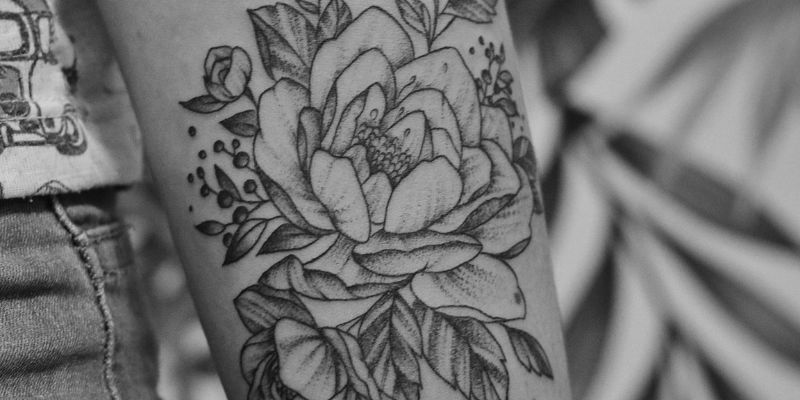Nick
What Is Tattoo Flash? The History, Purpose, and Modern Evolution
Walk into any traditional tattoo shop and you'll likely see walls adorned with colorful sheets of pre-drawn tattoo designs. These iconic displays aren't just decoration: they're "tattoo flash," a fundamental element of tattoo culture with a rich history and purpose. Whether you're a tattoo enthusiast or considering your first piece of body art, understanding tattoo flash can help you appreciate the art form's traditions while navigating modern options.
The Origins of Tattoo Flash
Tattoo flash emerged in the early 20th century when tattooing began transitioning from folk art to a commercial enterprise in Western countries. During this period, several key developments shaped what we now recognize as traditional flash:
- Maritime Influences: Sailors traveling between ports would collect tattoos as souvenirs, creating demand for quick, reproducible designs.
- Circus and Carnival Culture: Traveling shows featured tattooed performers and artists who needed portable design options.
- Mass Production Need: As tattooing grew in popularity, artists needed efficient ways to showcase available designs to customers.
Legendary tattoo artists like Sailor Jerry (Norman Collins), Bert Grimm, and Cap Coleman created distinctive flash sheets that defined the American Traditional style. These artists would hand-paint sheets of designs that could be easily replicated, establishing visual vocabularies that continue to influence tattoo art today.
What Makes It "Flash"
Tattoo flash has several distinguishing characteristics:
- Pre-designed: Unlike custom work, flash designs are created before a client requests them
- Reproducible: Intended to be tattooed multiple times with minimal variation
- Displayed Publicly: Typically arranged on sheets or "flash boards" visible in the shop
- Bold and Legible: Designed with strong outlines and simple color schemes that heal well and age gracefully
- Standardized Pricing: Often priced consistently based on size rather than complexity
Traditional flash typically features iconic imagery: anchors, eagles, roses, daggers, skulls, pin-up girls, and nautical themes. These images weren't chosen randomly—they carried symbolic meaning within sailor culture and broader society, serving as visual shorthand for concepts like courage, patriotism, love, and mortality.
The Purpose of Tattoo Flash
Flash serves several practical purposes in the tattoo world:
For Artists:
- Portfolio Display: Shows the artist's style and technical capabilities
- Time Efficiency: Eliminates the need to draw custom designs for every client
- Teaching Tool: Apprentices learn by copying flash, absorbing techniques and design principles
- Creative Foundation: Provides building blocks that can be combined into larger compositions
For Clients:
- Accessibility: Offers ready-made options for those without specific design ideas
- Decision Aid: Helps clients visualize potential tattoos
- Budget Option: Typically less expensive than fully custom work
- Traditional Connection: Links the wearer to tattoo history and tradition
The Evolution of Flash Through History
Tattoo flash has evolved significantly over the past century:
Early 20th Century: The Foundation
The first widely distributed flash sheets featured bold, simple designs intended for quick application. Artists like Percy Waters created mail-order catalogs of flash, standardizing certain images across the country.
Mid-Century: Refinement and Style Development
Artists like Sailor Jerry refined flash design, incorporating Japanese influences and developing more sophisticated color theory while maintaining the bold, readable approach necessary for successful tattoos.
1970s-1990s: Diversification
As tattooing entered mainstream consciousness, flash styles diversified. Artists developed personal flash sheets reflecting their unique aesthetics, from Ed Hardy's Japanese-influenced designs to Cliff Raven's nature-inspired work.
2000s-Present: Renaissance and Reinterpretation
Contemporary artists have embraced flash traditions while bringing modern sensibilities to the format. Flash has expanded to include diverse styles like neo-traditional, illustrative, blackwork, and minimalist approaches.
The Cultural Significance of Flash
Beyond its practical applications, tattoo flash holds important cultural significance:
- Historical Record: Flash sheets document evolving visual trends and social values
- Artistic Lineage: Connects contemporary tattooers to their predecessors
- Community Markers: Certain flash designs signify membership in specific communities
- Americana Art Form: Recognized as a distinctive American folk art tradition
Collecting vintage flash has become popular among both tattooers and art enthusiasts, with original sheets from pioneering artists fetching significant prices at auction.
Tattoo Flash in the Modern Era
Today's relationship with flash is complex and evolving:
The Custom vs. Flash Debate
While many contemporary clients seek completely custom work, there's been a renewed appreciation for the directness and cultural connection of traditional flash. Many artists now operate in both modes, creating original flash while also accepting custom commissions.
Flash Events and Guest Spots
"Flash days" have become popular events where artists offer limited-edition flash designs at special prices, creating excitement and collector interest.
Social Media Impact
Platforms like Instagram have transformed how flash is shared and consumed, with artists posting digital flash sheets that can reach global audiences instantly.
The AI Revolution in Tattoo Flash
Artificial intelligence is now opening exciting new possibilities in the world of tattoo flash:
Personalized Flash Generation
Unlike traditional flash, which offers the same designs to everyone, AI can generate personalized flash options based on individual preferences, creating a hybrid between fully custom work and traditional flash.
Style Exploration
AI systems can help both artists and clients explore diverse tattoo styles quickly, generating flash-style designs in various aesthetic traditions from American Traditional to Japanese Irezumi or Blackwork.
Accessibility and Visualization
For those who find tattoo shops intimidating or who aren't ready to commit to an appointment, AI tools provide a low-pressure way to explore potential designs and visualize them on their own body.
Creating Your Own Flash Experience with TattoosAI
This is where TattoosAI enters the picture. Our platform bridges traditional flash concepts with cutting-edge technology:
- Generate Personalized Flash: Describe the elements and style you want, and our AI creates unique flash-style designs tailored to your preferences
- Mix Traditional and Modern: Combine classic flash elements with contemporary twists
- Visualization Tools: See how flash designs would look on your body before making any commitments
- Artist Collaboration: Bring AI-generated flash concepts to your favorite tattoo artist as a starting point for discussion
Unlike traditional flash that might be tattooed hundreds of times, AI-generated flash gives you the immediacy and accessibility of flash with the personalization of custom work.
Tips for Working with Tattoo Flash
Whether you're considering traditional flash or exploring AI-generated options, here are some tips:
- Respect Tradition: Understand the historical context of classic flash imagery
- Expect Some Personalization: Even with traditional flash, most artists will make minor adjustments for placement and flow
- Consider Combinations: Flash elements often work well together in larger compositions
- Be Open to Interpretation: Allow artists some creative freedom in how they apply the design
- Start Simple: Flash designs with bold lines and minimal detail often age better than complex images
The Future of Flash
The future of tattoo flash lies in the balance between honoring traditions and embracing new technologies. As AI tools become more sophisticated, we're entering an era where:
- Artists can generate custom flash sheets based on their style and a client's preferences
- Historical flash can be preserved, studied, and reinterpreted through digital means
- The accessibility of tattoo design increases across geographic and economic barriers
- The distinction between custom work and flash becomes more fluid
At TattoosAI, we're excited to be part of this evolution, creating tools that respect tattoo traditions while making personalized design more accessible to everyone.
Experience the Best of Both Worlds
Tattoo flash represents the democratic spirit of tattooing—art that's accessible, bold, and carries cultural significance. AI-powered design tools take this accessibility to the next level, allowing anyone to experience the excitement of finding the perfect design without sacrificing personalization.
Ready to explore what modern flash design can look like for your next tattoo? Try TattoosAI today and discover how our platform can help you generate personalized flash designs that honor tradition while expressing your unique identity. No appointments necessary—just bring your ideas, and we'll help turn them into tattoo-ready designs you can take to your favorite artist.



